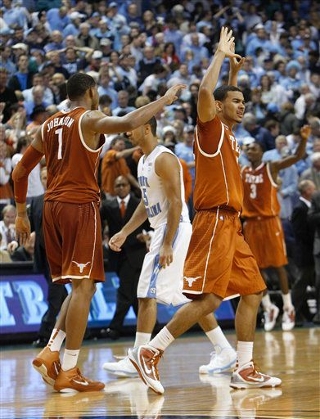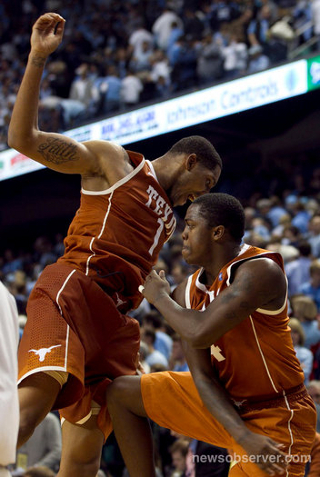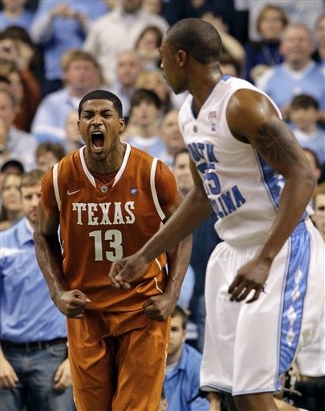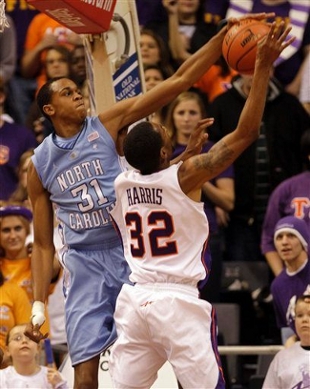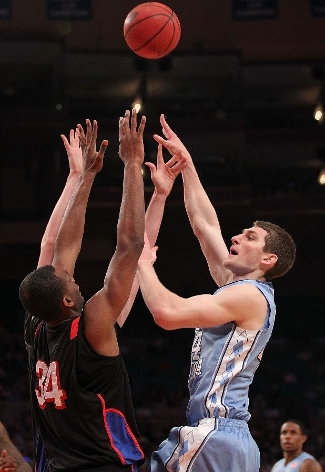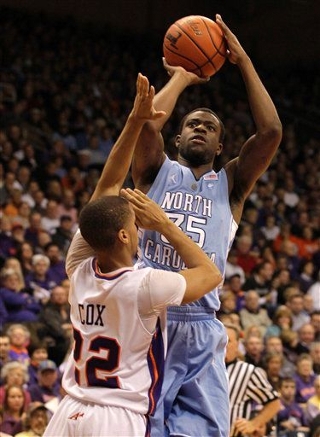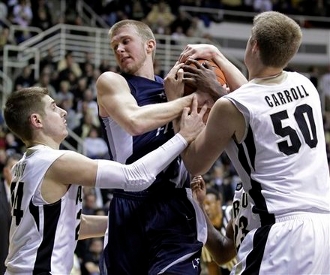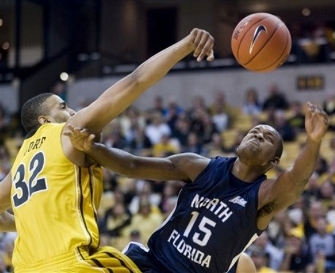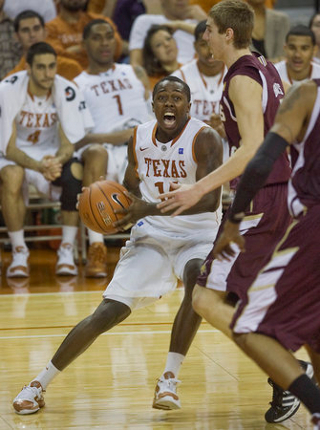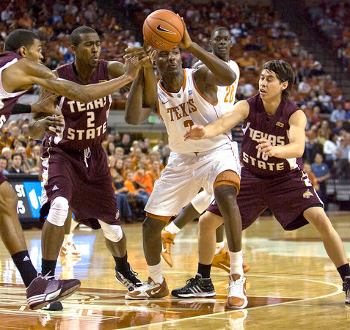With just seconds left in the game, Cory Joseph had a chance for redemption as he dribbled at the top of the key against North Carolina’s Dexter Strickland. Just a month earlier, Joseph threw up a prayer of a shot that could have tied the game against Pittsburgh at the buzzer. That night, the ball went nowhere near the basket. Now, with time running out against the Tar Heels, Coach Rick Barnes wanted his guard to attack the rim, draw a foul, and win it at the free-throw line. The freshman had a different idea. Standing near the free-throw line, Joseph pumped, getting Strickland to bite on the fake, then spun for a turnaround jumper. The crowd of 20,787 held its collective breath in anticipation, as the shot seemed to hang in the air for eternity. When the ball finally sailed through the net, the Greensboro Coliseum’s powder-blue contingent fell completely silent.
Cory Joseph sealed the big win for the Longhorns The clutch shot provided an exciting conclusion to a back-and-forth affair, and came just seconds after Carolina superfrosh Harrison Barnes had knotted the game with a three. Both teams had monumental runs in the see-saw battle, with Texas claiming a lead as large as ten before Carolina erased the deficit and built a seven-point run of their own. For the Longhorns, the 78-76 victory gave them a quality road win in a hostile environment, an experience the young team needed with road games against Kansas, Baylor, and Texas A&M waiting in conference play. It also marked the fourth straight time that Texas defeated North Carolina, a string dating back to the 1995 season. What looked good Jordan Hamilton had another excellent game, scoring a team-high 24 points, including a 4-of-7 mark from behind the arc. He seemed to thrive on the pressure, making four straight points when the team trailed by seven early in the second half. After his three-pointer pulled the Longhorns within two just minutes later, he openly celebrated and shot a Kobe-esque stare at his defender as they headed back down the court. Joseph was the second-leading scorer for the team, setting a new career-high with his 21-point performance. It marked the fourth time in the last six games that the freshman has bested his previous high-water mark, and it gave him a 19.3 PPG average over his last three contests. Cory’s increased confidence over the last month is a huge development for a Longhorn team that often has lineups with only two or three quality scorers on the floor at a time.
It was a win worth celebrating for Texas In this particular game, the Longhorns were hampered by foul trouble from the start, making Joseph’s gutsy performance even more important. With Matt Hill, Dogus Balbay, and Alexis Wangmene forced to play a combined 52 minutes thanks to the foul issues, the Longhorns had to have their capable scorers step up. Joseph’s willingness to shoulder the load is going to be huge when Texas inevitably faces the same depth issues later in the season. While Hill and Wangmene didn’t light up the scoreboard, they both played remarkably well for being thrust into a high-pressure situation against a talented North Carolina frontcourt. Wangmene had the best game of his career with Texas, grabbing nine boards — five of them on the offensive glass — while playing solid defense against the likes of Tyler Zeller and John Henson. Hill picked up some unnecessary fouls early and was beating himself up for the mistakes. During one first-half timeout, he even looked as his dad in the stands and mouthed “dumb fouls” as he shook his head in disgust. But Hill bounced back from the early setbacks, adjusted to the physical play down low, and managed to contribute four points and four boards on the afternoon. Most importantly, the Longhorns showed incredible poise in coming back to win the game. It would have been very easy for the team to fold after blowing their 10-point lead during a 29-12 Carolina run, especially in front of a frenzied crowd of more than 20,000. Instead, Texas chipped away at the lead and made the key plays down the stretch to secure an impressive road win. What needed work The biggest problem for the Longhorns came in the form of foul trouble. Having so many players pick up boneheaded fouls served to handcuff Barnes when it came to lineups, and it resulted in some really disappointing offensive results. Over the last seven and a half minutes of the first half, Texas made just two baskets, including one stretch of 4:10 without a basket. The offensive impotence allowed UNC to erase a 10-point Texas advantage and even take a one-point lead to the break. Fortunately, Carolina had their own lengthy scoring drought during that time, or else the results might have been even more disastrous for Texas.
Tristan Thompson played well down the stretch Tristan Thompson picked up a pair of fouls within the first three minutes of each half, and as a result he spent 24 of the first 29 minutes of the game on the bench. He drew one whistle by trying to tap at the ball on a rebound he was out of position on, and was tagged with another foul by playing too aggressively on defense 17 feet from the basket. Perhaps the freshman was too amped up for a road game against a big-name opponent, but he has to play smarter basketball. He should be commended for making a difference down the stretch while playing with four fouls, but in the future he must avoid the brain-lock that limited his minutes in this game. The Longhorns also had a hard time climbing the mountain during their comeback because they were giving up far too many easy points inside. Time and again, Texas failed to box out on the weak side, giving Carolina too many extra possessions. In fact, four different Tar Heel buckets in the second half were scored on tip-ins and putbacks. In addition, transition defense for the Longhorns was uncharacteristically pathetic. Nobody stopped the ball as the UNC guards flew down the court, and it resulted in far too many easy layups. On the rare occasion a Texas big would recognize the situation and flash out to stop the play, the late response left other Tar Heels open for midrange jumpers or threes. One final thing that was troubling in this game was that the Longhorns threw two or three inbounds passes directly into the near corner. Naturally, the Tar Heels immediately collapsed into a double team, which was especially effective with the length on their roster. Texas is going to face some very nasty, high-pressure defenses in Big 12 play, so this is a habit that must be broken. There’s simply no reason to waste possessions or time on the shot clock by passing into an easy double-team situation where the sideline acts as a third defender. Up next: at #15/14 Michigan State (8-3) |








